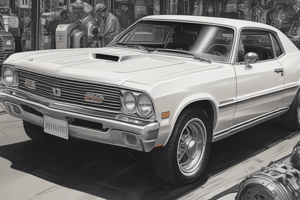Podcast
Questions and Answers
What is the primary function of engine oil?
What is the primary function of engine oil?
- To regulate engine temperature
- To lubricate engine components and reduce friction (correct)
- To circulate coolant through the system
- To filter out contaminants from fuel
What type of transmission fluid is used in manual transmissions?
What type of transmission fluid is used in manual transmissions?
- Manual transmission fluid (MTF) (correct)
- Automatic transmission fluid (ATF)
- Synthetic blend transmission fluid
- Continuously variable transmission fluid (CVTF)
What is the purpose of the thermostat in the coolant system?
What is the purpose of the thermostat in the coolant system?
- To filter out contaminants from the coolant
- To regulate engine temperature (correct)
- To circulate coolant through the system
- To dissipate heat in the radiator
What type of filter is typically used in air filtration systems?
What type of filter is typically used in air filtration systems?
What is the primary function of the radiator in the coolant system?
What is the primary function of the radiator in the coolant system?
What type of coolant is considered more environmentally friendly?
What type of coolant is considered more environmentally friendly?
What is the purpose of detergents in engine oil?
What is the purpose of detergents in engine oil?
What is the primary function of the water pump in the coolant system?
What is the primary function of the water pump in the coolant system?
What type of engine oil is recommended for cold weather?
What type of engine oil is recommended for cold weather?
What is the purpose of friction modifiers in transmission fluid?
What is the purpose of friction modifiers in transmission fluid?
Flashcards are hidden until you start studying
Study Notes
Engine Oil
- Function: Lubricates engine components, reduces friction, and prevents overheating
- Types:
- Conventional (petroleum-based)
- Synthetic (chemical-based)
- Synthetic blend (mix of conventional and synthetic)
- Viscosity: Measures oil's thickness and flowability
- Thin oils for cold weather, thick oils for hot weather
- Additives:
- Detergents: Neutralize acids and remove deposits
- Dispersants: Prevent soot and varnish buildup
- Anti-wear agents: Reduce friction and wear
Transmission Fluid
- Function: Lubricates transmission components, reduces friction, and prevents overheating
- Types:
- Automatic transmission fluid (ATF)
- Manual transmission fluid (MTF)
- Continuously variable transmission fluid (CVTF)
- Properties:
- Viscosity: Similar to engine oil, but with higher viscosity index
- Friction modifiers: Reduce clutch pack wear and improve shifting
- Anti-wear agents: Prevent gear and bearing wear
Filtration Systems
- Function: Remove contaminants from lubricants to prevent engine damage
- Types:
- Oil filters: Remove particles, soot, and varnish from engine oil
- Fuel filters: Remove particles and contaminants from fuel
- Air filters: Remove particles and contaminants from air
- Filter types:
- Cartridge-style filters
- Canister-style filters
- Synthetic media filters
Coolant System
- Function: Regulates engine temperature and prevents overheating
- Components:
- Radiator: Heat exchanger that dissipates heat
- Water pump: Circulates coolant through the system
- Hoses: Transport coolant between components
- Thermostat: Regulates engine temperature
- Coolant types:
- Ethylene glycol-based
- Propylene glycol-based
- Organic acid technology (OAT) coolants
Engine Oil
- Lubricates engine components, reduces friction, and prevents overheating
- Comes in three types: conventional, synthetic, and synthetic blend
- Viscosity measures oil's thickness and flowability, with thin oils for cold weather and thick oils for hot weather
- Additives include detergents to neutralize acids, dispersants to prevent soot buildup, and anti-wear agents to reduce friction
Transmission Fluid
- Lubricates transmission components, reduces friction, and prevents overheating
- Comes in three types: automatic transmission fluid (ATF), manual transmission fluid (MTF), and continuously variable transmission fluid (CVTF)
- Has a higher viscosity index than engine oil, with friction modifiers to reduce clutch pack wear and anti-wear agents to prevent gear wear
Filtration Systems
- Remove contaminants from lubricants to prevent engine damage
- Includes oil filters to remove particles and varnish, fuel filters to remove particles, and air filters to remove particles
- Filter types include cartridge-style, canister-style, and synthetic media filters
Coolant System
- Regulates engine temperature and prevents overheating
- Components include radiators, water pumps, hoses, and thermostats
- Coolants come in three types: ethylene glycol-based, propylene glycol-based, and organic acid technology (OAT) coolants
Studying That Suits You
Use AI to generate personalized quizzes and flashcards to suit your learning preferences.



